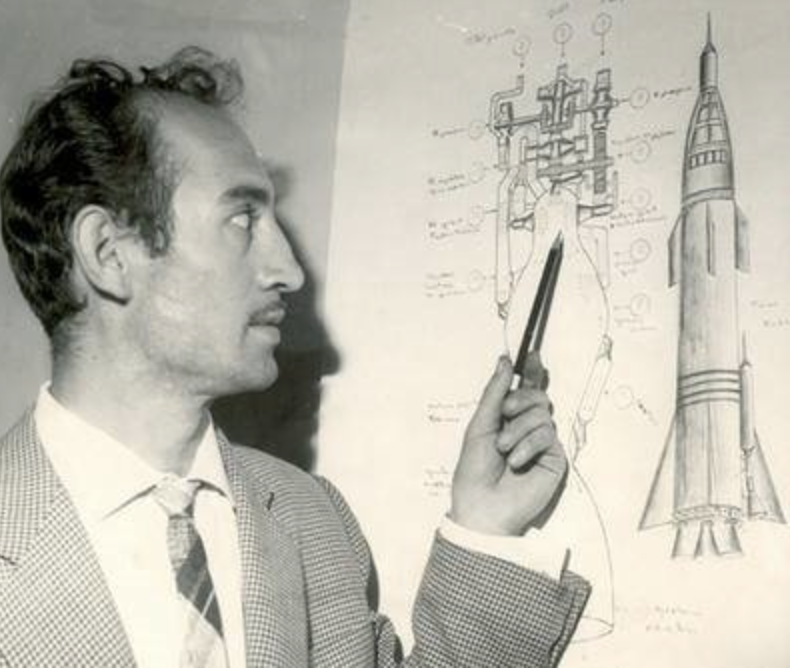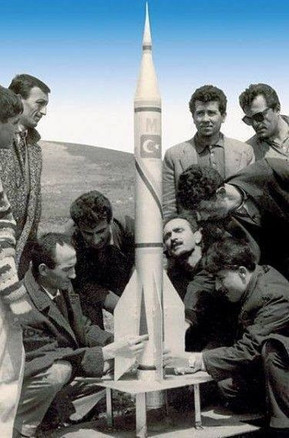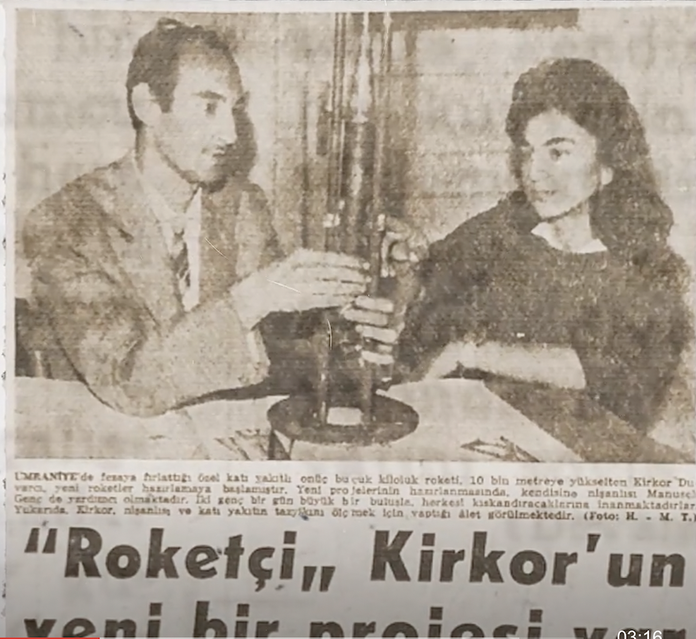In recent years, Turkey has become a global name in unmanned aerial vehicles (UAVs) and is making serious strides in space technology. With indigenous satellites in orbit and growing capabilities in rocket development, the country is often praised as an emerging aerospace power. Yet long before these headlines, in a very different era, a group of high school students in Bandırma and a self-taught jeweler from Üsküdar were already dreaming of space. Their story—mostly forgotten today—is one of youthful ambition, remarkable ingenuity, and heartbreaking obstacles. It’s time to revisit the bittersweet tale of Rocketman Kirkor Usta and the Bandırma Missile Club.

Kirkor Duvarcı
The Tragic Tale of Rocketman Kirkor Usta and the Bandırma Missile Club
In some parts of the world, imagination and ambition meet—but dreams still fail to take flight. Turkey is one such place.
The extraordinary story of the Bandırma Missile Club and Rocketman Kirkor Usta is one of wings broken just as they learned to soar… A tale of aiming for the skies but ending up trapped in craters. A unique source of inspiration—but also one soaked in that familiar, heavy disappointment. It’s the story of dreamers and the ones who broke their dreams. Let’s first look at the background.
After Sputnik, a Wave of Aspiring Rocketmen
When the Soviet Union launched Sputnik into orbit in 1957, a group of young people in Turkey, much like their counterparts around the world, came together and began eagerly working toward their own skyward journey. Sputnik had ignited an incredible wave of inspiration. Sketches were drawn, rockets designed, and amateur launches occurred in many parts of the globe. Some succeeded. Others had their enthusiasm dashed. But the passion gave birth to many sweet and sincere stories. In the following years, fascinating books would be written and films made about amateur rocketry.
What made the Bandırma Missile Club stand out from the global wave of amateur rocket enthusiasts was that they were actually quite successful—unexpectedly so. So much so that one might have hoped it would lead to more. But it didn’t.
As humanity once again sets its sights on the Moon, this beautiful but broken tale from our own country resurfaces. There’s even a movie about it: Bandırma Füze Kulübü, directed by Ömer Faruk Sorak.

The collaboration between Kirkor Usta and the youth of Bandırma
Turkey’s Own Space Clubs
As mentioned, the amateur rocketry wave spread across many countries. Turkey was no exception. In the wake of Sputnik’s excitement, many “missile” clubs sprang up in Anatolian towns. One of these was the Bandırma Missile Club, founded by high school students. They quickly made progress and launched their first rocket on October 10, 1959. The three-kilogram rocket, which newspapers claimed was “launched toward the Moon,” rose 40 meters before plunging into the sea.
The students kept working. Some of their rockets failed to lift off, others got tangled in parachutes—but some were successful. Newspapers followed these experiments closely. Alongside technical reports on the rocket launches, critical columns emerged urging the youth to “give it up already.” The club members also had to deal with mocking comments from locals. After all, in the now-familiar Turkish idiom, these kids were “inventing things out of nowhere.” So a correction had to be made.
Enter Kirkor Duvarcı: The Rocketman from Üsküdar
While the students in Bandırma carried on, another “mad inventor” was working away in Istanbul: 25-year-old jeweler Kirkor Duvarcı from Üsküdar. He too had been inspired by the global rocketry craze and began building his own rockets. He had no formal education in this field. He studied diagrams in newspapers and had a friend who worked in auto body repair build his designs. In this way, he launched nine small rockets and, in a sense, became something of an expert. His tenth rocket, launched in Ümraniye, was his first large rocket—marking the beginning of his master phase.

Rocketman Kirkor Usta and his fiancée Manusenk Genç
Kirkor Usta in the Spotlight
Like the Bandırma youths, Kirkor Usta began attracting media attention. For instance, one report noted that he had spent the 400 lira he and his fiancée had saved for marriage on rocketry. (One article even mentioned that his fiancée, Manusek Genç, was just as interested in “space science” and that the couple worked together on their rockets. A photo showed them standing with a prototype.)
But again, just like the students in Bandırma, Kirkor Usta faced daily mockery from others. He tried not to let it get to him.
Everyone in the amateur rocketry scene kept track of one another. Rocket fans from Tokat, Samsun, and other cities quickly heard of each other’s launches and traveled to witness the launches in person. That’s how Kirkor Usta met the Bandırma Missile Club—and in 1962, they joined forces.

Bandırma Missile Club movie poster
A Collaboration That Reached the Sky
The partnership bore fruit. In October 1962, their jointly built rocket “Marmara 4” reached an altitude of 5,415 meters. This achievement placed the Bandırma Missile Club and Kirkor Usta in third place globally, right behind amateur efforts in the U.S. and Germany.
Things were going well. Amateur rocketry was developing in Turkey. The Bandırma Missile Club and Kirkor Usta had new projects in mind. People worked passionately in the spirit of the “space age,” daring to dream of the Moon and beyond—even when it seemed far-fetched.
And Then? The Aftermath of the Dream
Then came the downturn. A mysterious fire broke out in Kirkor Usta’s home. All of his projects, notes, and documents were reduced to ashes. Having battled for years with limited resources and public ridicule, Kirkor Usta could not bear this final blow. He lost all motivation. He abandoned rocketry altogether.
The Bandırma Missile Club lasted longer than Kirkor Usta. Interest and membership grew. They even gained some support from military circles. But misfortunes still came. The club was accused of promoting American propaganda because of a model airplane displayed at an exhibition. In the politically turbulent second half of the 1970s, their rocket projects were shut down for “security reasons.”
Rocketman Kirkor and His Fiancée, Manusek Genç
Here’s what historian Reşad Ekrem Koçu wrote about Kirkor Usta in his Istanbul Encyclopedia:
“While still in the fourth grade, Kirkor Duvarcı built a battery-powered telephone device and used it to speak with his friends over a 200-meter distance. Over the years, his curiosity for mechanical inventions grew so strong that he began neglecting his jewelry shop—his actual profession. In his community, he became known as ‘Rocketman Kirkor.’
While all his relatives and friends urged him to return to his shop and earn a living, the only ones who truly believed in his inventor spirit were his fiancée, Ms. Manusek, and a welder in Üsküdar named Jirayin Zerunyan, who built his rocket parts.
According to Kirkor himself, all his knowledge came from newspapers, magazines, and movies. What he didn’t know, however, was that the world had long moved past the era of self-taught inventors. Still, there’s no denying that Kirkor Duvarcı was someone whose love-fueled talent could have been harnessed for the field of space exploration.”
